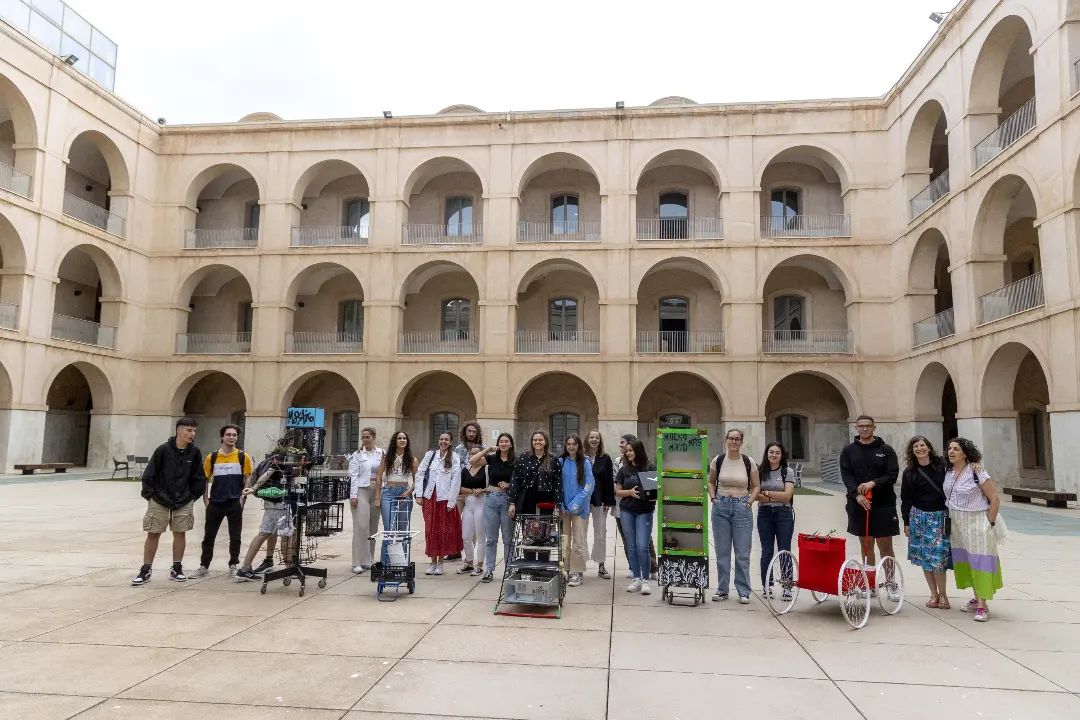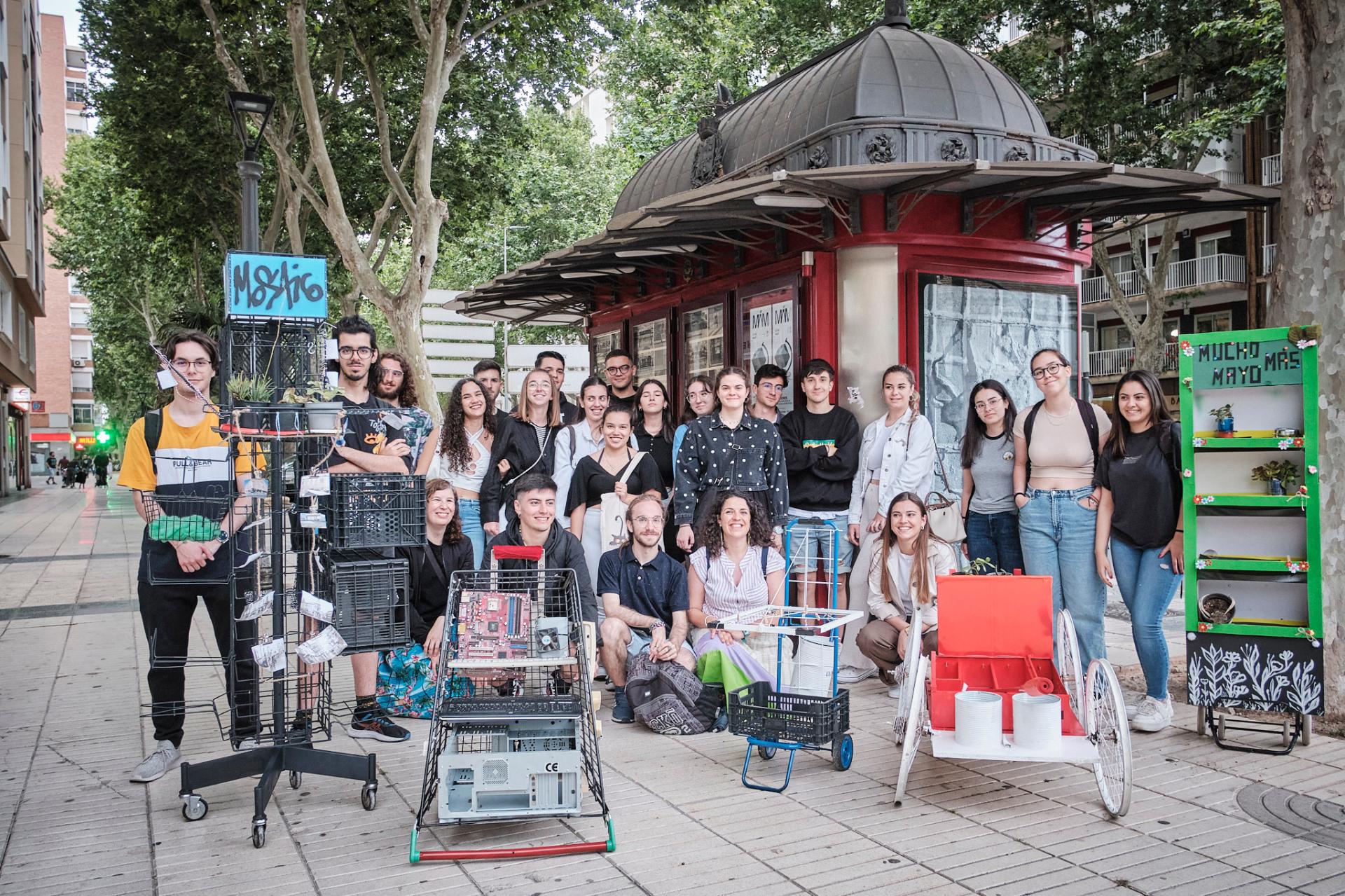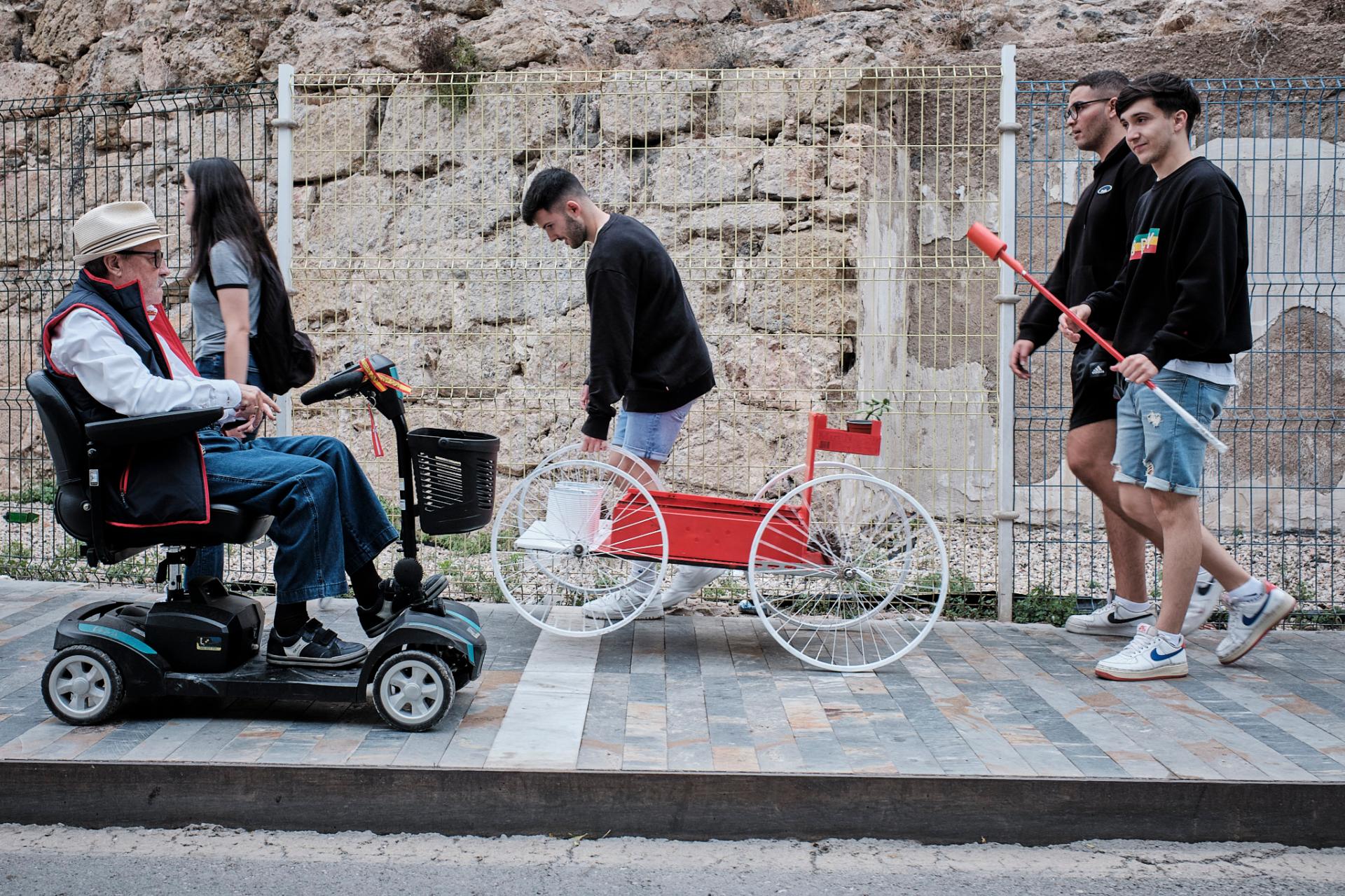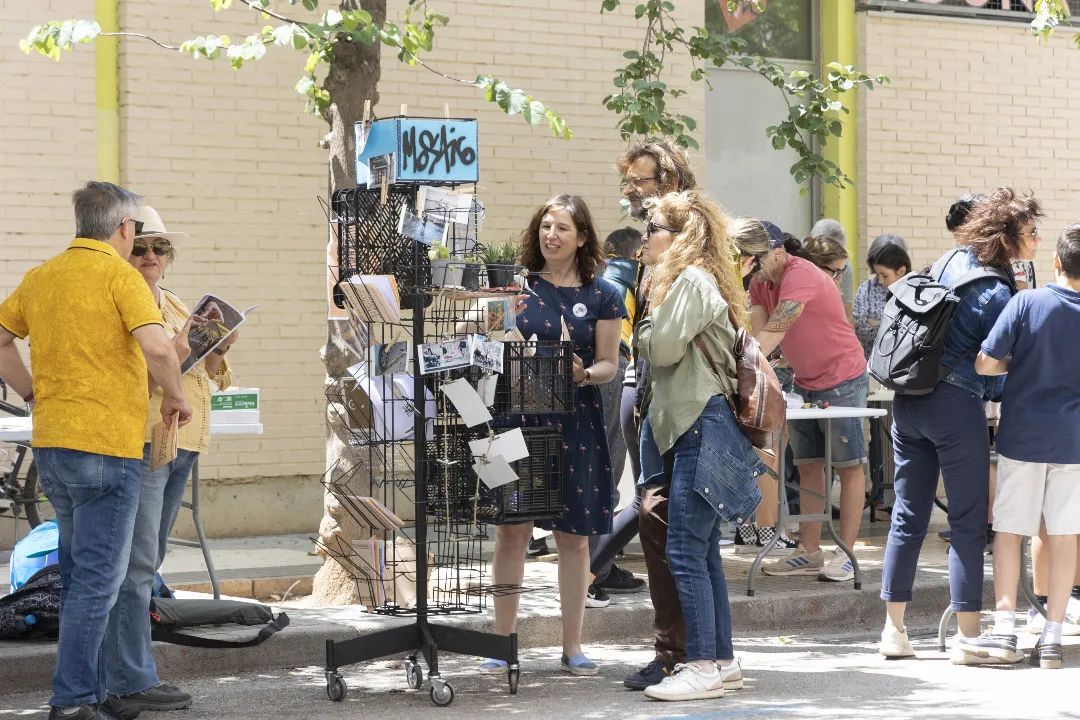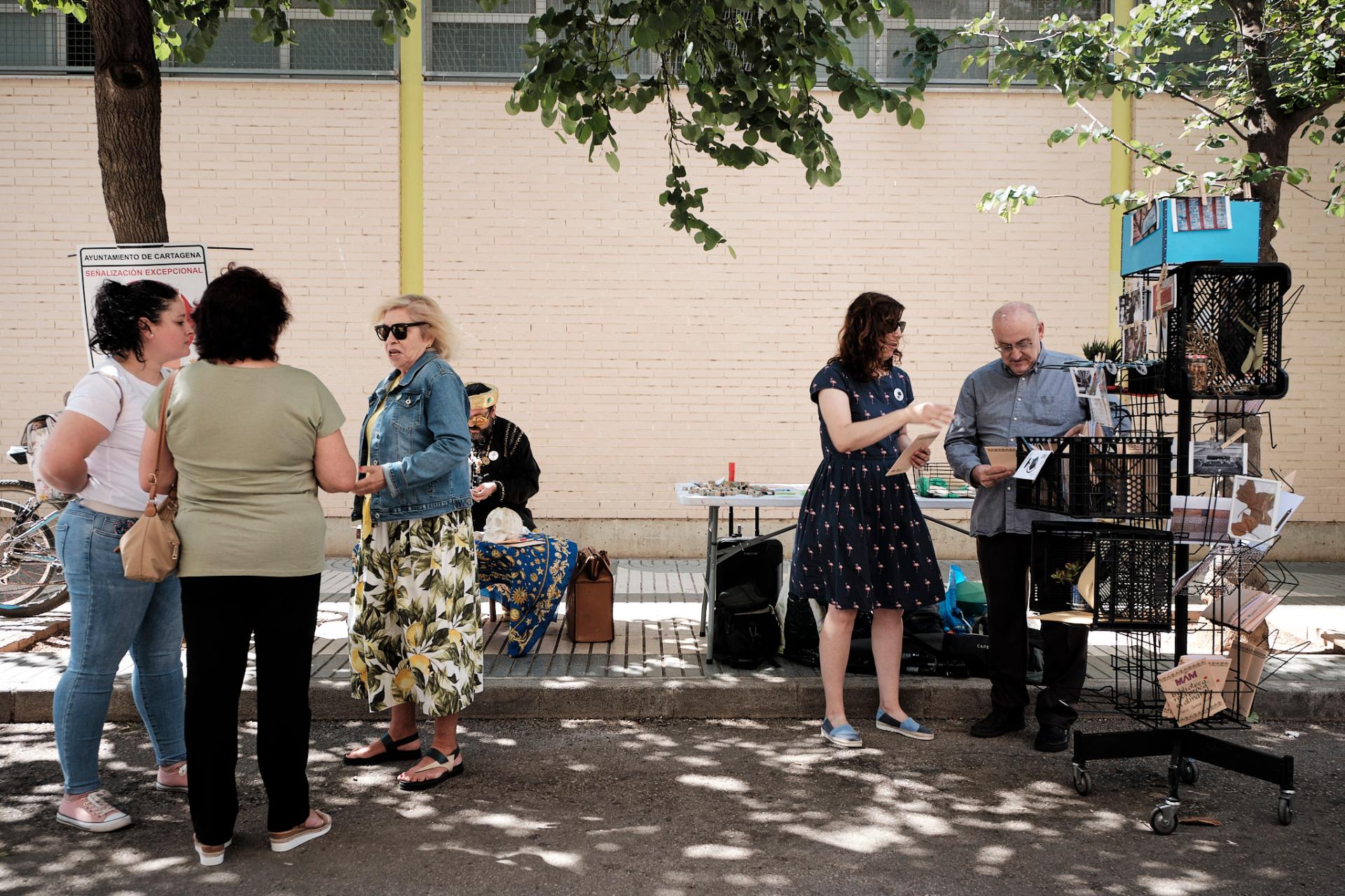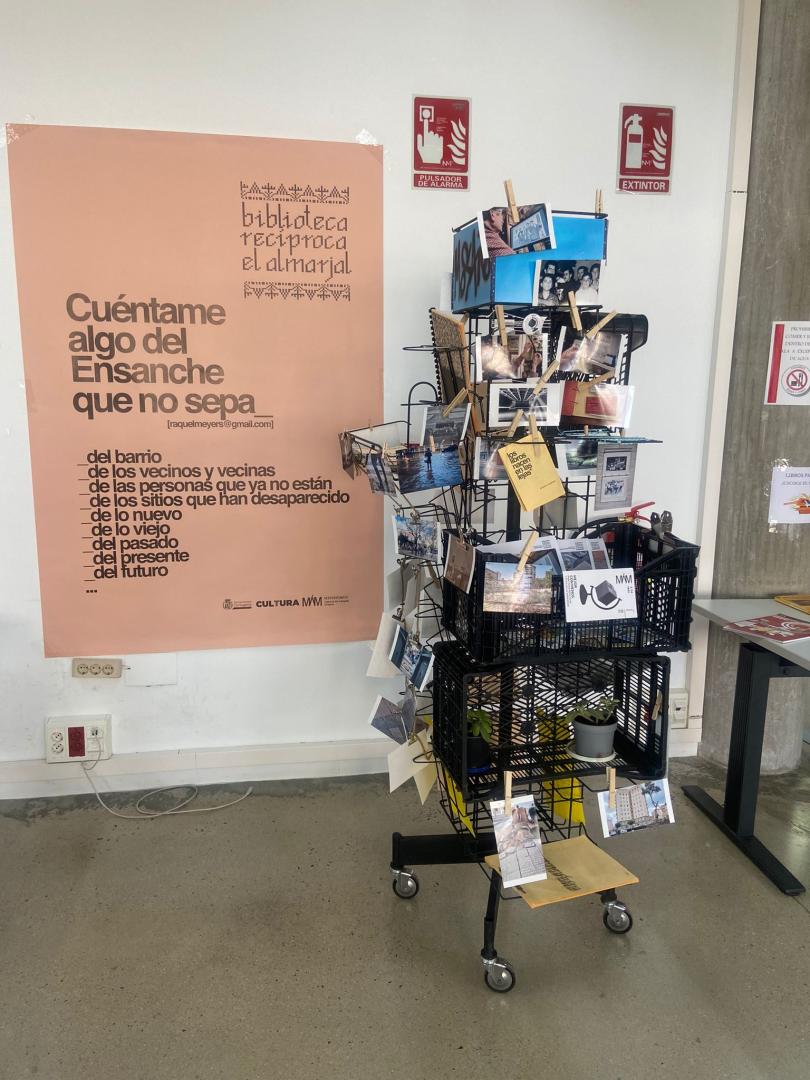Codesigning the world from the classroom
Basic information
Project Title
Codesigning the world from the classroom
Full project title
Applied design practices in the framework of real sustainability and ethical projects
Category
Shaping a circular industrial ecosystem and supporting life-cycle thinking
Project Description
This project works on the learning of sustainable design processes of the students at the Technical University of Cartagena through real and experimental work. To this end, they participate in an art festival that takes place in the city, making real models with circular economy elements.
Geographical Scope
Local
Project Region
Cartagena (Murcia, España), Spain
Urban or rural issues
Mainly urban
Physical or other transformations
It refers to other types of transformations (soft investment)
EU Programme or fund
No
Description of the project
Summary
This project is an initiative of the Technical University of Cartagena and Cartagena City Council, together with national artistic representatives. It is a teaching-artistic proposal that works on learning in the academic framework of the university through sustainable design tools and the real work of students in a city context. The aim of this project is double: that the classroom goes out into the street and uses the opportunities that the city offers us as innovative learning tools and, at the same time, that the city environment receives the creative capacity that emerges in the academic environment. To this end, the students design real objects for the public to use, within the framework of an art festival. In this context, we work on the main values of the New European Bauhaus, as we address sustainability, redesigning elements already in disuse, beauty in design processes and working with citizens, and their inclusion in design through methodologies such as Design Thinking. This connection between the classroom and the urban environment is materialized through the participation of students in the Mucho Más Mayo art festival, as a conceptual framework for the subjects that work on design processes within the Degree in Industrial Design Engineering and Product Development. The students have executed a design process by participating in the reflections of the art festival and working hand in hand with the festival's guest artist Raquel Meyers and the collaboration of the photographer Arkaitz Saiz-Calderon who has immortalized the whole process. This festival is a local program promoted by Cartagena City Council, which proposes reflections in different creative registers using public spaces. In the 2023 edition, the slogan of the festival was "BETTER WITH LESS Artistic practices and ethics of sobriety" and proposed to reflect on the paradigm shift that we must address as a society in relation to production and consumption to avoid climate collapse.
Key objectives for sustainability
The project has addressed the practice of design learning within the framework of the theme of climate change. In this sense, the students have developed a work process using the Design Thinking methodology to understand how climate change affects the residents of one of the areas of the city, and they have designed proposals and projects to solve them.
On the other hand, the results of the design process have been materialized in a trolley-object that has served as an exhibition of the results. These objects have been made from discarded elements, with all their components being 100% reused. In this way, the objects designed have recovered broken bookshelves, abandoned bicycle wheels, or disused book displays.
This proposal is exemplary as an educational project, as it offers new perspectives for working in the classroom and incorporates the necessary values of sustainability in the learning of the design exercise. On the other hand, the objects produced are also an important social asset, as they are not only circular elements, but are objects in use, designed for spaces such as the municipal library or neighbourhood associations.
On the other hand, the results of the design process have been materialized in a trolley-object that has served as an exhibition of the results. These objects have been made from discarded elements, with all their components being 100% reused. In this way, the objects designed have recovered broken bookshelves, abandoned bicycle wheels, or disused book displays.
This proposal is exemplary as an educational project, as it offers new perspectives for working in the classroom and incorporates the necessary values of sustainability in the learning of the design exercise. On the other hand, the objects produced are also an important social asset, as they are not only circular elements, but are objects in use, designed for spaces such as the municipal library or neighbourhood associations.
Key objectives for aesthetics and quality
The project is an educational proposal that proposes learning through the values of design and aesthetics, as these are the objectives of the subjects involved in the project: to teach students design strategies that address issues such as aesthetics, form, function, etc.
Furthermore, the working methodology used for the teaching strategy is Design Thinking. To do this, the students have explored the work environment, interviewing users and understanding the real problem from people's experience in order to establish challenges and finally imagine proposals and manufacture them.
This project is a reference in terms of the methodology it uses, as it incorporates the learning of Design Thinking and the students learn design beyond traditional values, facing the people for whom they are designing. On the other hand, the results of the work carried out have been executed and are currently being used by the citizens for whom they were designed. These project results are living elements that occupy public spaces in the city, showing how design can improve environments. Moreover, these designs are a real example of circular design, and the users of the library, education spaces or neighbourhood associations use them daily, showing an example of real design use of obsolete elements that have been given a new life.
Furthermore, the working methodology used for the teaching strategy is Design Thinking. To do this, the students have explored the work environment, interviewing users and understanding the real problem from people's experience in order to establish challenges and finally imagine proposals and manufacture them.
This project is a reference in terms of the methodology it uses, as it incorporates the learning of Design Thinking and the students learn design beyond traditional values, facing the people for whom they are designing. On the other hand, the results of the work carried out have been executed and are currently being used by the citizens for whom they were designed. These project results are living elements that occupy public spaces in the city, showing how design can improve environments. Moreover, these designs are a real example of circular design, and the users of the library, education spaces or neighbourhood associations use them daily, showing an example of real design use of obsolete elements that have been given a new life.
Key objectives for inclusion
This project has been developed within the emerging art festival Mucho Más Mayo (https://muchomasmayo.cartagena.es/), a local program promoted by Cartagena City Council, which proposes reflections in different creative registers using public spaces and unconventional places in the city. It is developed through experimental processes that relate the practice of design with interaction with citizens, participation and cultural production. In addition, the theme of the festival always includes reflections related to current challenges, closely aligned with the integration of the SDGs, proposing interventions that mainly address social and environmental issues. In the case of the 2023 edition, the festival's theme is "BETTER WITH LESS Artistic practices and ethics of sobriety” and proposes to reflect on the paradigm shift that we must address as a society, in relation to production and consumption that avoids climate collapse.
As well described in this theme, the festival addresses critical issues related to the objectives of the NEB, which should not be overlooked by the academic community. It is in this inspiring framework that the present educational-artistic project is built, which aims to use learning tools of design processes, using a real and current challenge.
On the other hand, the project represents a collaboration between different organizations and the private initiative itself. The University, the City Council and artistic practice come together to work together to improve working environments.
The methodology used by the students for the design of the solutions has closely followed the citizenry, since at the beginning of the project the students have explored the working environments, interviewing users and taking into account their concerns and problems so that the resulting proposals address the perception of citizens in a real way.
As well described in this theme, the festival addresses critical issues related to the objectives of the NEB, which should not be overlooked by the academic community. It is in this inspiring framework that the present educational-artistic project is built, which aims to use learning tools of design processes, using a real and current challenge.
On the other hand, the project represents a collaboration between different organizations and the private initiative itself. The University, the City Council and artistic practice come together to work together to improve working environments.
The methodology used by the students for the design of the solutions has closely followed the citizenry, since at the beginning of the project the students have explored the working environments, interviewing users and taking into account their concerns and problems so that the resulting proposals address the perception of citizens in a real way.
Results in relation to category
An innovative teaching methodology has been implemented in design subjects that will be replicated in different subjects of the Design degree at the Technical University of Cartagena.
Moreover, the project reaches out to multiple actors who have benefited in different ways:
- The teachers of the subjects have organized and implemented the activities within the framework of the subjects and have also developed their own methodology. This project has also been selected as a teaching innovation project by the university.
- The 50 students participating in the courses have learned and worked on the design process, learning about the New European Bauhaus initiative, the Design Thinking methodology, participating in the Mucho Mas Mayo art festival and an art project, working first-hand with an international artist.
- The artist Raquel Meyers has been able to realize an inclusive art project, working with numerous agents and enriching her artistic production.
- Cartagena City Council has promoted an activity that has generated a large turnout and participation, enhancing the inclusivity and acceptance of the festival.
- The public has benefited from both participation in the festival and its aftermath. During the execution of the festival (May 2023) around half a thousand people participated in different activities in which the designed objects were used. Moreover, after the end of the festival, the designed objects are currently used by thousands of people in different municipal facilities.
In addition to all these benefits and results, the objects built will last for a longer life cycle. All the trolleys were made from discarded elements, with all their components being 100% reused, and are still in use today in public spaces, so they continue to offer the public a reflection of the reflections in the classroom, and of Raquel Meyers' artistic work.
Moreover, the project reaches out to multiple actors who have benefited in different ways:
- The teachers of the subjects have organized and implemented the activities within the framework of the subjects and have also developed their own methodology. This project has also been selected as a teaching innovation project by the university.
- The 50 students participating in the courses have learned and worked on the design process, learning about the New European Bauhaus initiative, the Design Thinking methodology, participating in the Mucho Mas Mayo art festival and an art project, working first-hand with an international artist.
- The artist Raquel Meyers has been able to realize an inclusive art project, working with numerous agents and enriching her artistic production.
- Cartagena City Council has promoted an activity that has generated a large turnout and participation, enhancing the inclusivity and acceptance of the festival.
- The public has benefited from both participation in the festival and its aftermath. During the execution of the festival (May 2023) around half a thousand people participated in different activities in which the designed objects were used. Moreover, after the end of the festival, the designed objects are currently used by thousands of people in different municipal facilities.
In addition to all these benefits and results, the objects built will last for a longer life cycle. All the trolleys were made from discarded elements, with all their components being 100% reused, and are still in use today in public spaces, so they continue to offer the public a reflection of the reflections in the classroom, and of Raquel Meyers' artistic work.
How Citizens benefit
This project is a teaching-artistic proposal that works on learning in the academic framework of the university through sustainable design tools and the real work of the students in a city context. The entire design process carried out by the students has been based on the real needs of citizens in a specific environment in the city of Cartagena, defined within the framework of the Mucho Más Mayo Art Festival. The students worked with the citizens, conducting interviews, and collecting their main problems. Throughout the process, solutions have been projected and finally manufactured and used by the users of the different environments, so that the academic work has left the classroom and has been used in a real way. Citizens have actively participated in the project during all the phases.
With this project, our aim is for the classroom to go out into the street and use the opportunities that the city offers us as innovative learning tools that activate the pupils and, in short, make them the protagonists. The students have designed real objects for citizens to use, and these objects are also the result of a process of redesigning discarded materials, offering users the opportunity to reflect on how to obtain value from reuse and the circular economy.
The objects designed by the students are currently part of the furniture of the municipal library of Cartagena, the neighbourhood residents' association, and the Technical University of Cartagena. These exhibition trolleys display the work of the artist and the students during the festival.
With this project, our aim is for the classroom to go out into the street and use the opportunities that the city offers us as innovative learning tools that activate the pupils and, in short, make them the protagonists. The students have designed real objects for citizens to use, and these objects are also the result of a process of redesigning discarded materials, offering users the opportunity to reflect on how to obtain value from reuse and the circular economy.
The objects designed by the students are currently part of the furniture of the municipal library of Cartagena, the neighbourhood residents' association, and the Technical University of Cartagena. These exhibition trolleys display the work of the artist and the students during the festival.
Physical or other transformations
It refers to other types of transformations (soft investment)
Innovative character
There are many challenges for teachers when it comes to teaching sustainable design strategies in subjects with this objective. The use of case studies, visits to real contexts, etc. allow us to get closer to the real world, but in many cases the traditional tools we have are not enough to tackle the exercise of designing in all its complexity. With this educational-artistic project we propose that the classroom goes out into the street and uses the opportunities that the city offers us as innovative learning tools that activate the pupils and, in short, make them protagonists. In addition, the students design real objects for citizens to use, within the framework of an art festival, and reflecting on the main values of the New European Bauhaus, as it addresses sustainability, the beauty of design elements and working with citizens through design methodologies such as Design Thinking.
Disciplines/knowledge reflected
The three representatives of this project: the Technical University of Cartagena through its professors, the guest artist Rachel Meyers, the photographer Arkaitz Saiz-Calderón Sagarzazu, and the City Council of Cartagena through its Director of Culture Patricio Hernández, have collaborated in the whole process, from the initiative to the development and the final presentation during the festival.
The disciplines involved have been all those related to the design process: ideation, sketches, design, collection of materials, construction of the object, exhibition of the projects, etc.
The disciplines involved have been all those related to the design process: ideation, sketches, design, collection of materials, construction of the object, exhibition of the projects, etc.
Methodology used
In the subject of this project, within the Degree in Industrial Design Engineering and Product Development, the design of a project and its manufacture is proposed through practical exercises that deal with contextual learning. This takes the form in three specific exercises, and it is explained in the methodological diagram attached to the proposal. The theme of the festival runs through the three exercises as a common thread. In the first of them, the students will leave the classroom to work in the area proposed by the festival (the area of the widening of the city of Cartagena, Murcia, Spain), they will design a proposal for intervention in the second exercise and develop a physical element built in the last one.
The festival provides us with the theme of the entire course, framed around the challenges of climate action and how we designers should work the design exercise in this context.
Within the framework of this proposal, the students also work with an artist, who offers a vision of the real world and the complexity of the solutions worked on. The students work on the manufacturing process of a trolley that is used during the festival activities and which is now also part of the furniture of spaces such as the library or the neighbourhood residents' association.
In this way, the students not only exercise the design process, but also work with real professionals, and their work will offer material results that will be seen by all the citizens. This methodology is graphically described in one of the images attached to this call for entries.
The festival provides us with the theme of the entire course, framed around the challenges of climate action and how we designers should work the design exercise in this context.
Within the framework of this proposal, the students also work with an artist, who offers a vision of the real world and the complexity of the solutions worked on. The students work on the manufacturing process of a trolley that is used during the festival activities and which is now also part of the furniture of spaces such as the library or the neighbourhood residents' association.
In this way, the students not only exercise the design process, but also work with real professionals, and their work will offer material results that will be seen by all the citizens. This methodology is graphically described in one of the images attached to this call for entries.
How stakeholders are engaged
The Technical University of Cartagena, within the subjects focused on the design process of the Degree in Industrial Design and Product Development Engineering, has developed a didactic methodology for its teaching activities focused on the development of the object proposed for the festival. The students worked on each of the development phases, including the manufacture of the objects. Subsequently, they participated in the festival with the street exhibition, showing their proposals to the public.
Rachel Meyers (https://www.raquelmeyers.com/), a guest artist at the art festival, was the one who proposed the initiative of the object to be developed. The artist, with her visits to the university, brought her practical vision of the design exercise to the classroom and worked with the students in the process of making the trolley. The objects made were used during the activities of the festival and have subsequently formed part of the furniture of spaces such as the library or the neighbourhood residents' association.
Cartagena City Council, through its Director of Culture Patricio Hernández, was the driving force behind the "Mucho Mas Mayo" Festival program (https://muchomasmayo.cartagena.es/). This emerging art festival proposes reflections in different creative registers using public spaces and unconventional places in the city. In the 2023 edition, the festival's motto is "BETTER WITH LESS Artistic practices and ethics of sobriety" and proposes to reflect on the change of paradigm that we must address as a society, in relation to production and consumption that avoids climate collapse.
Rachel Meyers (https://www.raquelmeyers.com/), a guest artist at the art festival, was the one who proposed the initiative of the object to be developed. The artist, with her visits to the university, brought her practical vision of the design exercise to the classroom and worked with the students in the process of making the trolley. The objects made were used during the activities of the festival and have subsequently formed part of the furniture of spaces such as the library or the neighbourhood residents' association.
Cartagena City Council, through its Director of Culture Patricio Hernández, was the driving force behind the "Mucho Mas Mayo" Festival program (https://muchomasmayo.cartagena.es/). This emerging art festival proposes reflections in different creative registers using public spaces and unconventional places in the city. In the 2023 edition, the festival's motto is "BETTER WITH LESS Artistic practices and ethics of sobriety" and proposes to reflect on the change of paradigm that we must address as a society, in relation to production and consumption that avoids climate collapse.
Global challenges
Any global or worldwide solution starts from the smallest or local solutions. Therefore, it is necessary to raise public awareness on key issues that affect us all, such as the environment. Any individual citizen's response has a global impact, like the butterfly effect. That is why any project like the one we present is an important grain of sand for the reflection of the main values of the New European Bauhaus: sustainability, reuse of products, responsible consumption, waste reduction, etc. to reduce to a greater or lesser extent the carbon footprint, and promoting a circular economy of products that minimizes the environmental impact.
Learning transferred to other parties
This project can be replicated anywhere, where at least one educational institution and one public institution are involved. The educational institution could be of any educational level, each one can be approached with a different level of difficulty. In the case of the public institution, its intervention is necessary to promote this type of activities in the street, as a focus for new innovative proposals, for a real citizen participation, which serves to address the new challenges of society such as sustainability, responsible consumption, and circular economy.
Keywords
Design
Sustainability
Citizen participation
Responsible manufacturing
Innovative teaching

